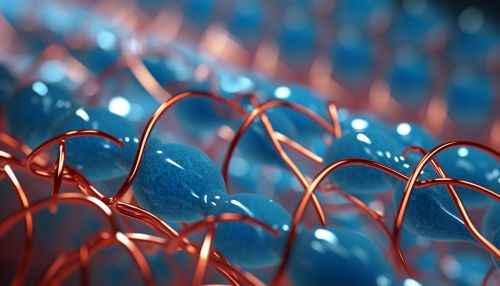MTOR
Introduction
The mammalian target of rapamycin (mTOR) is a type of protein kinase that regulates cell growth, cell proliferation, cell motility, cell survival, protein synthesis, and transcription. mTOR is a key player in cell signalling and is associated with other proteins to form two distinct complexes: mTOR Complex 1 (mTORC1) and mTOR Complex 2 (mTORC2). These complexes are crucial for the regulation of various cellular processes and have been implicated in a number of diseases, including cancer, cardiovascular disease, and neurological disorders.


Structure and Function
mTOR is a 289-kDa serine/threonine protein kinase that belongs to the phosphatidylinositol 3-kinase (PI3K)-related kinase family. The mTOR protein is composed of several domains, including the FAT (FRAP, ATM, TRRAP) domain, the FRB (FKBP12-rapamycin binding) domain, the kinase domain, and the FATC (FAT C-terminal) domain. The mTOR protein forms two distinct complexes, mTORC1 and mTORC2, each with unique components and functions.
mTOR Complex 1 (mTORC1)
mTORC1 is composed of mTOR, regulatory-associated protein of mTOR (Raptor), mammalian lethal with SEC13 protein 8 (mLST8), and the non-core components PRAS40 and DEPTOR. mTORC1 is sensitive to the immunosuppressive drug rapamycin and regulates cell growth and proliferation by integrating inputs from growth factors, energy status, stress, and amino acids. mTORC1 controls protein synthesis by phosphorylating key regulators of mRNA translation such as S6 kinase 1 (S6K1) and eukaryotic translation initiation factor 4E-binding protein 1 (4E-BP1).
mTOR Complex 2 (mTORC2)
mTORC2 consists of mTOR, rapamycin-insensitive companion of mTOR (Rictor), mLST8, and the non-core components Protor-1, DEPTOR, and mSin1. mTORC2 is generally insensitive to rapamycin and regulates cell survival and cytoskeletal organization. mTORC2 phosphorylates members of the AGC family of protein kinases, including Akt, serum- and glucocorticoid-induced protein kinase 1 (SGK1), and protein kinase C (PKC).
Role in Cellular Processes
mTOR plays a central role in a variety of cellular processes, including cell growth and proliferation, autophagy, and cell survival. The activity of mTOR is regulated by a variety of signals, including growth factors, nutrients, energy status, and stress.
Cell Growth and Proliferation
mTORC1 promotes cell growth and proliferation by stimulating protein synthesis. This is achieved through the phosphorylation of S6K1 and 4E-BP1, which leads to the initiation of cap-dependent translation. mTORC1 also promotes lipid synthesis and inhibits autophagy, further contributing to cell growth.
Autophagy
Autophagy is a cellular process that degrades and recycles cellular components to maintain cellular homeostasis. Under nutrient-rich conditions, mTORC1 inhibits autophagy by phosphorylating and inhibiting the Unc-51 like autophagy activating kinase 1 (ULK1). However, under conditions of nutrient deprivation or stress, mTORC1 is inhibited, leading to the activation of ULK1 and the initiation of autophagy.
Cell Survival
mTORC2 promotes cell survival by activating Akt, a protein kinase that promotes cell survival and growth by inhibiting pro-apoptotic factors and promoting cell cycle progression.
mTOR Signaling Pathways
mTOR integrates signals from a variety of sources to regulate cell growth, proliferation, and survival. The two major signaling pathways that regulate mTOR activity are the PI3K/Akt pathway and the AMP-activated protein kinase (AMPK) pathway.
PI3K/Akt Pathway
The PI3K/Akt pathway is activated by growth factors and insulin. Activation of PI3K leads to the production of phosphatidylinositol (3,4,5)-trisphosphate (PIP3), which recruits Akt to the plasma membrane where it is activated by phosphorylation. Activated Akt then phosphorylates and inhibits the tuberous sclerosis complex (TSC), a negative regulator of mTORC1. This leads to the activation of mTORC1 and the promotion of cell growth and proliferation.
AMPK Pathway
The AMPK pathway is activated by conditions of energy stress, such as low ATP levels. Activated AMPK phosphorylates and activates TSC, leading to the inhibition of mTORC1 and a reduction in cell growth and proliferation. AMPK can also directly phosphorylate and inhibit mTORC1.
Role in Disease
Dysregulation of mTOR signaling has been implicated in a variety of diseases, including cancer, cardiovascular disease, and neurological disorders.
Cancer
In many types of cancer, mTOR signaling is hyperactive, leading to increased cell growth and proliferation. This can occur through mutations in upstream regulators of mTOR, such as PI3K and PTEN, or through activation of growth factor signaling pathways. Inhibition of mTOR with drugs such as rapamycin and its analogs (rapalogs) has shown promise in the treatment of certain types of cancer.
Cardiovascular Disease
mTOR signaling plays a role in the development of cardiovascular disease by promoting cell proliferation and survival, contributing to the development of atherosclerotic plaques. mTOR inhibitors have been used to coat coronary stents to prevent restenosis after angioplasty.
Neurological Disorders
Mutations in mTOR or its upstream regulators can lead to neurological disorders such as tuberous sclerosis complex and epilepsy. mTOR inhibitors are currently being investigated as potential treatments for these disorders.
